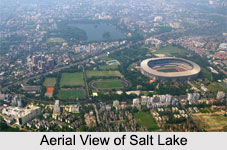 Salt Lake City is a planned satellite town in West Bengal. It was developed between 1958 and 1965 to accommodate the growing population of Kolkata. Salt Lake City is also called Bidhannagar in honour of the then chief minister of Bengal, Dr.Bidhan Chandra Ray who was instrumental in the development of this satellite township.
Salt Lake City is a planned satellite town in West Bengal. It was developed between 1958 and 1965 to accommodate the growing population of Kolkata. Salt Lake City is also called Bidhannagar in honour of the then chief minister of Bengal, Dr.Bidhan Chandra Ray who was instrumental in the development of this satellite township.
History of Salt Lake
In 1865, the British Government in India started reclaiming these salt water bodies of SaltLake by connecting it with Maratha Ditch. In 1878, the British Government leased out the right of the place to Nandalal Das and Durgacharan Kundu till 1887. On 30th April 1890, the Government again advertised in the newspaper and gave the leasehold right to the highest bidder, Bhabanath Sen. The said right ended in 1899 and in 1906, the Government again leased out the lakes for 10 years.
Geography of Salt Lake
Salt Lake City is gifted with many wetlands and lakes that still surround Bidhannagar or Salt Lake. Bidhannagar is located at 22.58 degree north to 88.42 degree east. It has an average elevation of 11 m. Salt Lake City is the most enriched part of Kolkata as it is very near to the airport. Many of the fast-growing IT companies are located in this area. Salt Lake has its existence as the marshland, which was connected once with Maratha Ditch of Kolkata. It was the ditch made by the people of Kolkata in 17th century during the time of Siraj ud daullah to protect Kolkata from the invasion of Marathas.
Planning of Salt Lake
Salt Lake City is now the economic and social expansion and is famous as the centre for IT in the city. Originally, Salt Lake was built and developed under the direct administration of the irrigation and Waterways Department of the Government of West Bengal. Later in 1995, Bidhannagar got its own elected body called Bidhannagar Municipality consisting of 23 wards which was later increased to 25 wards.
Demography of Salt Lake
According to the reports of Census India 2011, Salt Lake City had a population of 218,323 with 111,363 males and 106,960 females. Bidhannagar or Salt Lake has an average literacy rate of 90.44 percent with male literacy of 93.08 percent and female literacy of 87.69 percent.
Attractions of Salt Lake
Attractions in Salt Lake are located very adjacent to Lake Town and Rajarhat, this place has many places of attractions. The City Centre, Yuva Bharati Krirangan (Salt Lake Stadium) Nicco Park, Aquatica, and Science and Technology Ground and Central Park are the popular attractions in Salt Lake. Central Park is the largest park in the Kolkata urban area after the Maidan. Central Park is about 100 acres and Banabitan is administered by the Forest Department.



















